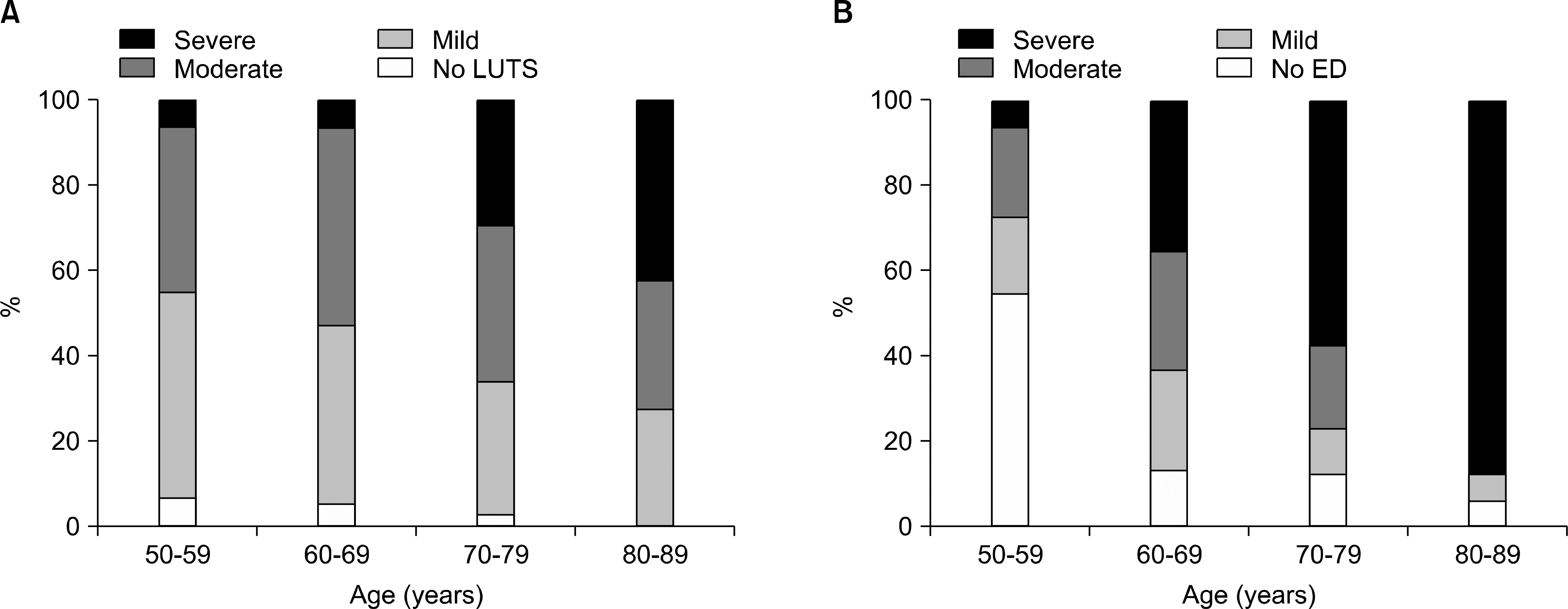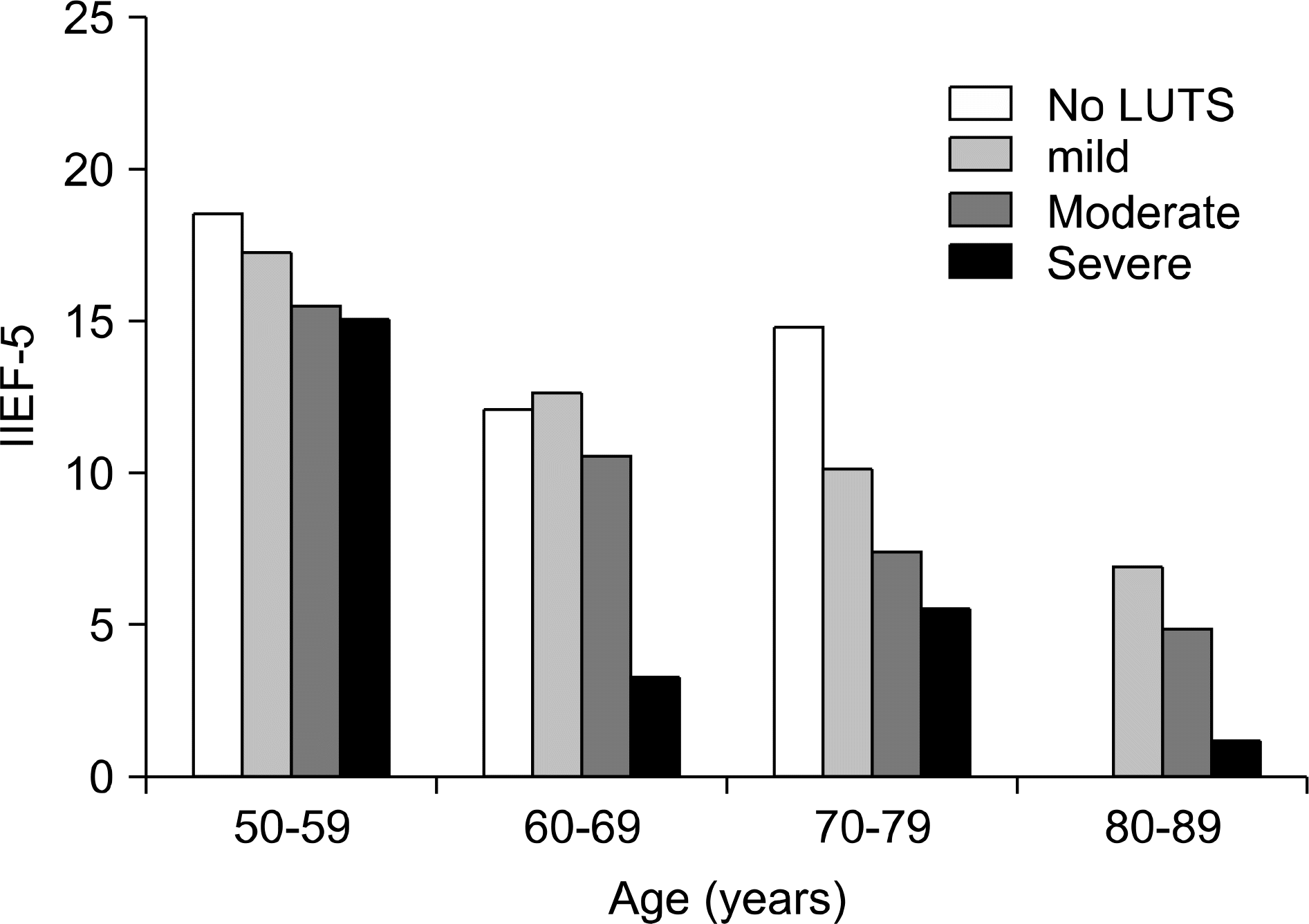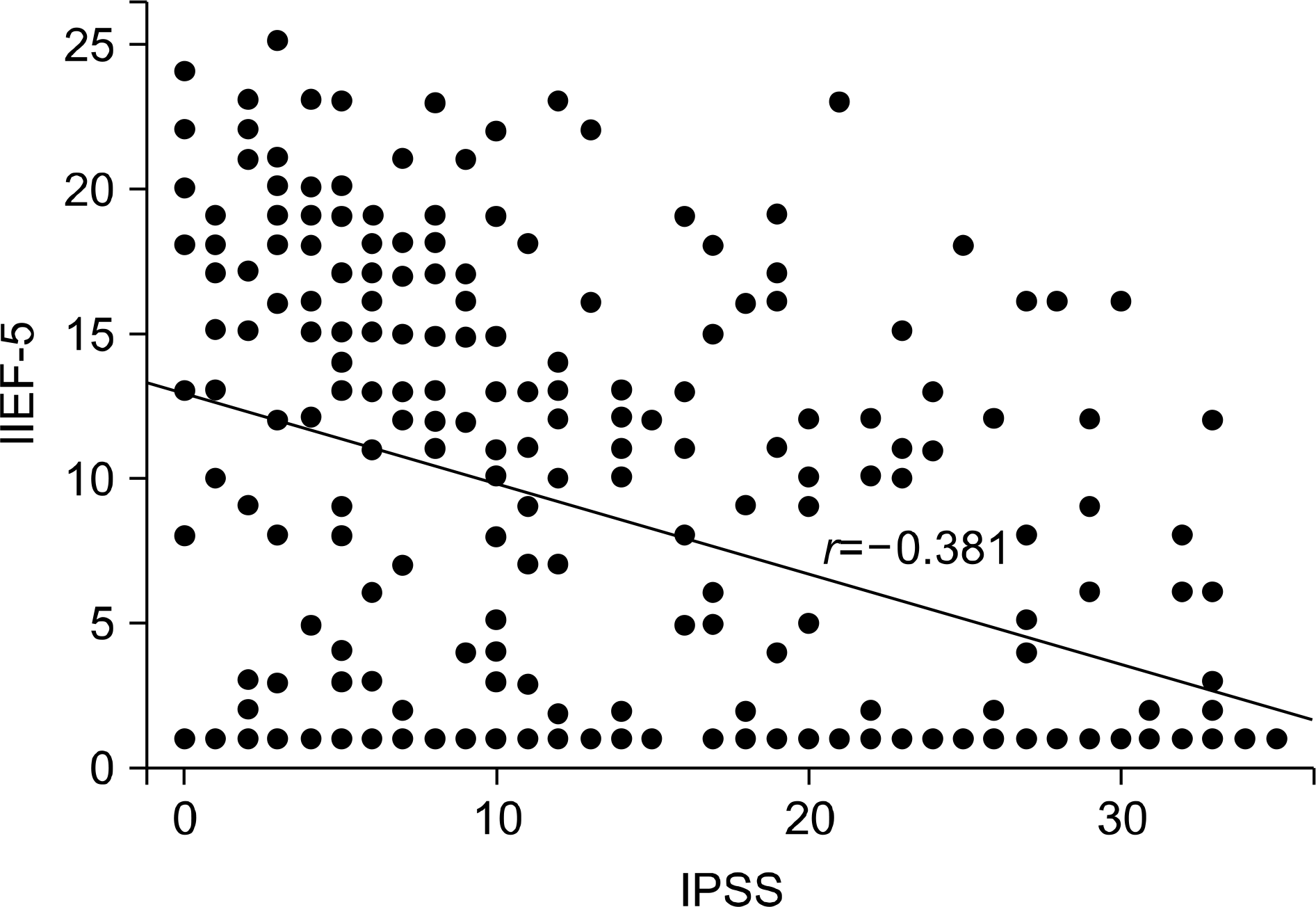Abstract
Purpose
The aim of this study was to investigate the relationship between lower urinary tract symptoms (LUTS) and erectile dysfunction (ED) in a population-based cohort study, Hallym Aging Study (HAS).
Materials and Methods
Among the 1,520 participants in HAS, 300 men aged ≥50 years, who underwent detailed health evaluations, includeing health-related questionnaires, evaluation of the medical history and various life style factors as well as clinical measurements, were included in the study. LUTS and ED were assessed by validated questionnaires, the International Prostate Symptom Score (IPSS) and a 5-item version of the International Index of Erectile Function (IIEF-5).
Results
The prevalence and severity of LUTS and ED increased and significantly with age (p<0.001). The IIEF-5 score declined as the severity of LUTS increased in each age group. There was a significant negative correlation between the IPSS score and the IIEF-5 score (age adjusted r= −0.275, p<0.001). The multivariate logistic regression analysis, controlling for age and comorbidities, showed that men with moderate/ severe LUTS were 4-9 times more likely to have ED than men with no/mild LUTS; in addition, men with ED were 5 times more likely have moderate/severe LUTS than men without ED.
Go to : 
REFERENCES
1.Kupelian V., Wei JT., O'Leary MP., Kusek JW., Litman HJ., Link CL, et al. Prevalence of lower urinary tract symptoms and effect on quality of life in a racially and ethnically diverse random sample: the Boston Area Community Health (BACH) Survey. Arch Intern Med. 2006. 166:2381–7.
2.Prins J., Blanker MH., Bohnen AM., Thomas S., Bosch JL. Prevalence of erectile dysfunction: a systematic review of population-based studies. Int J Impot Res. 2002. 14:422–32.

3.Sasayama S., Ishii N., Ishikura F., Kamijima G., Ogawa S., Kanmatsuse K, et al. Men's Health Study: epidemiology of erectile dysfunction and cardiovascular disease. Circ J. 2003. 67:656–9.
4.Nicolosi A., Moreira ED Jr., Shirai M., Bin Mohd Tambi MI., Glasser DB. Epidemiology of erectile dysfunction in four countries: cross-national study of the prevalence and correlates of erectile dysfunction. Urology. 2003. 61:201–6.

5.Brookes ST., Link CL., Donovan JL., McKinlay JB. Relationship between lower urinary tract symptoms and erectile dysfunction: results from the Boston Area Community Health Survey. J Urol. 2008. 179:250–5.

6.Ponholzer A., Temml C., Obermayr R., Madersbacher S. Association between lower urinary tract symptoms and erectile dysfunction. Urology. 2004. 64:772–6.

7.Mariappan P., Chong WL. Prevalence and correlations of lower urinary tract symptoms, erectile dysfunction and incontinence in men from a multiethnic Asian population: results of a regional population-based survey and comparison with industrialized nations. BJU Int. 2006. 98:1264–8.

8.Braun MH., Sommer F., Haupt G., Mathers MJ., Reifenrath B., Engelmann UH. Lower urinary tract symptoms and erectile dysfunction: co-morbidity or typical “Aging Male” symptoms? Results of the “Cologne Male Survey”. Eur Urol. 2003. 44:588–94.

9.Terai A., Ichioka K., Matsui Y., Yoshimura K. Association of lower urinary tract symptoms with erectile dysfunction in Japanese men. Urology. 2004. 64:132–6.

10.Rosen R., Altwein J., Boyle P., Kirby RS., Lukacs B., Meuleman E, et al. Lower urinary tract symptoms and male sexual dysfunction: the multinational survey of the aging male(MSAM-7). Eur Urol. 2003. 44:637–49.
11.Barry MJ., Fowler FJ Jr., O'Leary MP., Bruskewitz RC., Holtgrewe HL., Mebust WK, et al. The American Urological Association symptom index for benign prostatic hyperplasia. The Measurement Committee of the American Urological Association. J Urol. 1992. 148:1549–57.
12.Ahn TY., Lee DS., Kang W., Hong JH., Kim YS. Validation of an abridged Korean version of the International Index of Erectile Function (IIEF-5) as a diagnostic tool for erectile dysfunction. Korean J Urol. 2001. 42:535–40.
13.Cho KS., Jo MK., Lim D., Son H., Park SK., Yoo KY, et al. Epidemiologic survey using International Prostate Symptom Score (I-PSS) of lower urinary tract symptoms (LUTS) in elderly men above 40 years old in Seoul area. Korean J Urol. 2001. 42:840–8.
14.Son H., Byun SS., Park E., Cho KS., Jo MK., Kim SW, et al. Prevalence of sexual dysfunction in men older than 40 living in Seoul: epidemiologic survey using questionnaire. Korean J Urol. 2002. 43:52–61.
15.Oh SY., Min KS., Choi SH. Effects of prostate volume and lower urinary tract symptoms on erectile function. Korean J Urol. 2007. 48:24–8.

16.Shiri R., Häkkinen JT., Hakama M., Huhtala H., Auvinen A., Tammela TL, et al. Effect of lower urinary tract symptoms on the incidence of erectile dysfunction. J Urol. 2005. 174:205–9.

17.McVary KT. Sexual dysfunction in men with lower urinary tract symptoms and benign prostatic hyperplasia: an emerging link. BJU Int. 2003. 91:770–1.

19.Golomb E., Rosenzweig N., Eilam R., Abramovici A. Spontaneous hyperplasia of the ventral lobe of the prostate in aging genetically hypertensive rats. J Androl. 2000. 21:58–64.
20.McVary KT., McKenna KE. The relationship between erectile dysfunction and lower urinary tract symptoms: epidemiological, clinical, and basic science evidence. Curr Urol Rep. 2004. 5:251–7.

21.Chang S., Hypolite JA., Zderic SA., Wein AJ., Chacko S., DiSanto ME. Enhanced force generation by corpus cavernosum smooth muscle in rabbits with partial bladder outlet obstruction. J Urol. 2002. 167:2636–44.

22.Chang S., Hypolite JA., Zderic SA., Wein AJ., Chacko S., Disanto ME. Increased corpus cavernosum smooth muscle tone associated with partial bladder outlet obstruction is mediated via Rho-kinase. Am J Physiol Regul Integr Comp Physiol. 2005. 289:R1124–30.

23.Tarcan T., Azadzoi KM., Siroky MB., Goldstein I., Krane RJ. Age-related erectile and voiding dysfunction: the role of arterial insufficiency. Br J Urol. 1998. 82(Suppl 1):26–33.

24.Sairam K., Kulinskaya E., McNicholas TA., Boustead GB., Hanbury DC. Sildenafil influences lower urinary tract symptoms. BJU Int. 2002. 90:836–9.

25.Brookes ST., Donovan JL., Peters TJ., Abrams P., Neal DE. Sexual dysfunction in men after treatment for lower urinary tract symptoms: evidence from randomised controlled trial. BMJ. 2002. 324:1059–61.

26.Cha JS., Park JK. Association between lower urinary tract symptoms and erectile dysfunction. Korean J Urol. 2005. 46:1023–7.
Go to : 
 | Fig. 1.Prevalence and severity of lower urinary tract symptoms (LUTS) (A) and erectile dysfunction (ED) (B) in different age groups of the study population. |
 | Fig. 2.The International Index of Erectile Function (IIEF-5) score by severity of lower urinary tract symptoms (LUTS) in each age group. |
 | Fig. 3.Correlation of the International Prostate Symptom Score (IPSS) and International Index of Erectile Function (IIEF-5). Age adjusted partial Pearson’s correlation coefficient: r=−0.275 (p< 0.001). |
Table 1.
The demographic characteristics of respondents
Table 2.
IPSS and IIEF-5 scores by age group
| Age group, mean±SD | Total | p-value* | ||||
|---|---|---|---|---|---|---|
| 50-59 | 60-69 | 70-79 | 80-89 | |||
| IPSS | 7.7±5.7 | 9.6±6.4 | 13.5±9.5 | 16.6±10.3 | 12.4±9.1 | <0.05 |
| IPSS-storage | 3.1±2.4 | 4.1±3.1 | 5.5±4.1 | 7.4±4.3 | 5.2±3.9 | <0.05 |
| IPSS-voiding | 4.6±3.7 | 5.5±4.3 | 8.0±5.9 | 9.5±6.7 | 7.3±5.7 | <0.05 |
| IIEF-5 | 16.5±5.3 | 11.0±6.4 | 7.9±6.9 | 3.8±6.0 | 9.0±7.3 | <0.05 |
Table 3.
Multivariate logistic regression results for the relative risk of ED by LUTS severity and comorbidity
| ED Odds ratio* (95% confidence interval) | ||
|---|---|---|
| LUTS severity | ||
| No LUTS | 1 | 1 |
| Mild | 1.63 (0.32-8.35) | |
| Moderate | 6.95 (1.26-38.36)† | 4.41 (2.02-9.64)†‡ |
| Severe | 14.88 (1.75-126.36)† | 9.48 (2.06-43.58)†‡ |
| Age | 1.09 (1.04-1.14)† | |
| Body mass index (≥25kg/m2) | 1.77 (0.84-3.75) | |
| Diabetes mellitus | 2.54 (0.54-11.90) | |
| Hypertension | 2.08 (0.88-4.91) | |
| Hyperlipidemia | 1.26 (0.22-7.15) | |
| Cerebral vascular accident | 2.58 (0.31-21.42) | |
| Smoking | 1.14 (0.52-2.51) | |
| Alcohol | 1.17 (0.56-2.41) | |
Table 4.
Relative risk of ED by individual items on the IPSS
| Odds ratio | 95% confidence interval | |
|---|---|---|
| Incomplete emptying | 1.32* | 1.03-1.68 |
| Frequency | 1.47* | 1.12-1.92 |
| Intermittency | 1.40* | 1.09-1.80 |
| Urgency | 1.60* | 1.17-2.19 |
| Weak stream | 1.49* | 1.20-1.85 |
| Hesitancy | 1.48* | 1.11-1.98 |
| Nocturia | 1.67* | 1.20-2.32 |
Table 5.
Multivariate logistic regression results for the relative risk of moderate/severe LUTS by ED severity and comorbidity
| Moderate/severe LUTS Odds ratio* (95% confidence interval) | ||
|---|---|---|
| ED severity | ||
| No ED | 1 | 1 |
| Mild | 2.17 (0.89-5.29) | |
| Moderate | 6.98 (2.93-16.64)† | 4.89 (2.38-10.02)†‡ |
| Severe | 6.04 (2.70-13.53)† | |
| Age | 1.02 (0.99-1.06) | |
| Body mass index (≥25kg/m2) | 0.82 (0.49-1.40) | |
| Diabetes mellitus | 0.75 (0.35-1.60) | |
| Hypertension | 0.89 (0.51-1.55) | |
| Hyperlipidemia | 0.56 (0.15-2.05) | |
| Cerebral vascular accident | 0.99 (0.40-2.42) | |
| Smoking | 1.05 (0.58-1.90) | |
| Alcohol | 0.86 (0.52-1.45) | |




 PDF
PDF ePub
ePub Citation
Citation Print
Print


 XML Download
XML Download